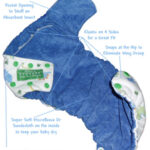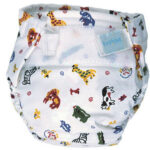Over the past five weeks I’ve bought more brand name food, paper goods, diapers and toiletries than we’ve ever had in our house at one time. Yet I’ve saved money doing it and have reduced my monthly grocery budget by several hundred dollars. My technique is fairly simple: I signed up to participate in The Grocery Game on www.thegrocerygame.com. Now, don’t rush to join the Game just because I said it worked for me. While The Grocery Game has the potential to help people save a lot of money on groceries, it’s just not the kind of “game” that everyone would enjoy or be willing to participate in.
The Grocery Game was first established by Teri Gault for members in Southern California. It has since expanded to stores in 48 states. It professes to help people save money on groceries (including food products, baby and pet products, paper products, drug store items, and other toiletries) by using a database to track product prices and coupons and by giving a weekly list of which sales at your local grocery or drug store are truly “rock bottom” prices. It costs $1 for a one-month trial to see any or all of the “List stores” in your area. After the trial period you pay $10 for one List store for every 8 weeks plus an extra $5 for each additional List store during that same time frame.
On the public message board for The Grocery Game (www.terismessageboard.com), you will find many posts by people who really do appear to be saving money. Each week, members can report their savings which might range from, for example, 35% to 90%. Some of the savings members report on the message board may seem unbelievable, but I can confirm what they are saying because I’m experiencing it, too. After these five weeks, I’ve saved more than 80% at some stores and am averaging about 43% savings overall. I expect my average to go even higher as I get better at the Game.
I attribute my success to being willing to spend more time getting ready to shop and more time organizing my coupons. If you really want to save money on groceries with The Grocery Game, you have to be willing to follow a few unwritten rules. The Grocery Game works if:
1. You have coupons or are willing to get them. The Grocery Game offers access to online coupon clipping services and coupon trains (where people exchange coupons by mail). Although I have not done this, it also recommends getting more than one Sunday paper so you can get more than one set of coupon inserts each week.
2. You’re willing to organize and use your coupons. It takes time to do this, and you have to be willing to spend that time. Grocery Gamers use a variety of methods to organize their coupons and they often discuss those methods on the public message board.
3. You have room to stockpile the products you buy. The Grocery Game works on the concept of buying in bulk when there’s a great deal so you don’t need to buy the product again until the next great deal comes along. You don’t need a lot of room, but if you’re going to buy 4 packs of toilet paper, 10 cans of green beans, 8 bags of frozen broccoli, and 5 bottles of hair spray, you may want to have someplace to put it all.
4. You’re willing to spend time getting ready to shop each week. Each week you’ll need to print off The Grocery Game List, decide what you’re going to buy, and find the coupons for those products. At first I spent upwards of 2 extra hours a week because I also compared the List to my store’s weekly sales circular. After five weeks I’m now spending about an hour extra to get ready. I see myself spending a little less time as more time passes, but I also expect that I’ll always spend more time getting ready to shop than I spent before I joined The Grocery Game. I’m willing to spend that time because I’m saving enough money to justify the extra time.
5. You don’t know the rock bottom price for products or you don’t want to or have the time to keep track of them. I thought I knew good prices for some products until I got the List. Now I know for example that where I live, I should never have to pay anything for some products (like toothpaste and toothbrushes) and I should never buy deodorant or brand name cereal if it’s going cost me $1 or more for the product. I still have no idea when a meat sale is a good deal because for some reason those prices just don’t stick in my head. The Grocery Game makes it so I don’t have to clutter my mind with all that information.
6. You know rock bottom prices, but you don’t have time to pore through the store sales flyers to identify the best deals of the week.
7. You can control yourself when a good sale is in your line of vision. The Grocery Game will show you the rock bottom prices on a lot of products. If you’re the type of person who can’t pass up a good deal, you may actually end up spending more on groceries or at least spending money on unnecessary products. The art is to know which products your family needs or uses and to focus only on getting those products. Don’t get caught up in the game, so to speak.
The Grocery Game is working for me and I expect to remain signed up and paying for the Game for some time to come. If you think you can follow these unwritten rules, then I encourage you to sign up for the trial month. But if you know you can’t follow the unwritten rules, be honest with yourself. The Grocery Game just might not be the best game for you.






